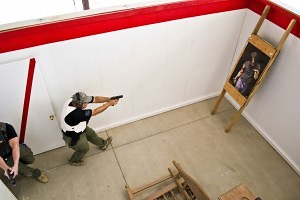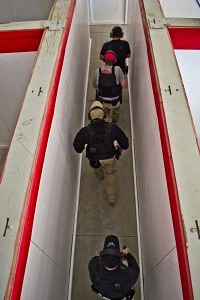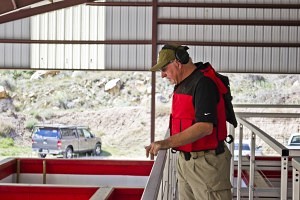By Bob Schneider
I was first introduced to live fire shoot house training in 1986 at the world famous Gunsite Academy in northern Arizona. I had already been a Denver, Colorado, police officer for more than 10 years and was then a member of its full-time special weapons and tactics team (SWAT). Prior to transferring to SWAT, I was a patrol officer assigned to the northeastern quadrant of the city and county of Denver.
As a police officer, I had to search many businesses after silent alarms had been tripped as well as respond to calls that put me inside someone’s house. I had been trained to conduct building searches and how to handle calls inside structures, but I had not been exposed to firing live ammunition in that training arena. Was I sufficiently trained to conduct such police actions? I believed I was, but my eyes were opened to a higher level of training that my department had not exposed me to.
In 1993, my department received a civil judgment against it for not providing adequate training to its police officers. My department had not provided “periodic target course shoot/don’t shoot live training under street conditions, particularly for officers on the front line.”1 We had required our officers to qualify once a month (later changed to quarterly) on a live fire course on a square range. This traditional range is exactly the same as all firearms ranges in the country used for law enforcement qualification and training. But our qualification courses did not require decision making, had little to no movement by the shooter, and was performed under adequate lighting conditions. The qualification target would turn and face the shooter which initiated the officer to present his/her weapon and fire the required number of rounds into the target before it edged away. This is the standard for all law enforcement agencies in the country. Then, some type of score is given for the officers’ records. If the officer passed, no further action was required. No additional training was given.
We know today that periodic qualification is just the beginning for our officers’ records. Continuing education is required in subject areas such as changes in the law or department regulations relating to the use of force, other options available other than the use of deadly force, and the list goes on. We now know we have a responsibility and obligation to expose our officers in training to as many situations as possible that they may encounter on the street.
If you believe you do have a responsibility and obligation to train your officers to the highest possible level, and your officers may find themselves in a structure like a building or house or business, then you need a live fire shoot house.
Historically, live fire shoot houses have been made out of old automobile tires, plywood, cinder blocks, and other material that stops bullets. My SWAT team even made portable bullet traps that allowed us to make any building into a live fire shoot house. With today’s modern technology in clean ammunition and live fire shoot house construction, we have no excuse not to train our officers in live fire indoor simulators.
Companies such as Action Target make an excellent portable bullet trap![]() . Its design and construction allow law enforcement agencies to tailor a structure to their environmental and economic needs.
. Its design and construction allow law enforcement agencies to tailor a structure to their environmental and economic needs.
I call it the “pay now or pay later” program. You can either pay now to build an indoor live fire simulator or you can pay later for not providing this level of training to your officers. You make the decision. If it was my decision, I would pay now. I would play every possible card in my deck to get a live fire shoot house.
Contact Action Target for options about getting your shoot house. I am confident that they will help you with your needs.
About Bob Schneider

Bob Schneider retired from the Denver, Colorado, Police Department after 21 years of service. He spent 18 years assigned to his department’s full-time special weapons and tactics team. He is a certified firearms and less-lethal weapons instructor and has taught classes to federal, state, and local law enforcement officers as well as to U.S. and foreign military units here and overseas. Bob has developed several firearms and tactics courses to include training scenarios that are being used by popular simulator manufacturers. He currently lives in Denver, Colorado, with his two sons, Dylan and Jake.
The views and opinions expressed in this article are those of the author and do not necessarily reflect the official position of Action Target as a company.
1. Zuchel v. City and County of Denver, Colo., 997 F. 2d 730 – Court of Appeals, 10th Circuit 1993.







This would be great if the department I work for would do this. Or any training for that matter. I work for a small Sheriffs Department in Kentucky that dosent even mandate qualification on firearms. The last time I qualified was at a required inservice yearly training. Very unfortunate
Sir, I would like information on any company designing and building modern day shoot houses with sufficient ventilation to reduce lead exposure levels with large operations going on inside.
Do you know of any companies that can design, build and maintain a shoot house/facility in a high-operational tempo training School on Fort Bragg?
Are there any websites available where I can see these facilities or vidoe where I can see them in use?
Thanks
SFC A.
SFC Acosta,
We design, manufacture, and install shoot house facilities here at Action Target. We’ve actually built several shoot houses and shoot house villages for government agencies and military bases. One of our biggest is at Fort Benning in Georgia. We installed two shoot house villages there (seven houses each) with single and multi story units, interconnecting tunnels, tactical roof entries, and a full camera after action review system.
We’re working on producing more video for our Modular Armored Tactical Combat House (MATCH), but this document should provide you with the information you need.
https://f3e21fcc14.nxcli.net/wp-content/uploads/2010/09/MATCH_Military_Brochure.pdf
I’ll also have the head of our military department contact you if you have any questions.